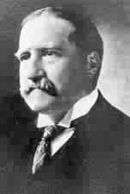John Kean (New Jersey)
| John Kean | |
|---|---|
 | |
| Member of the U.S. House of Representatives from New Jersey's 3rd district | |
|
In office March 4, 1883 – March 3, 1885 | |
| Preceded by | Miles Ross |
| Succeeded by | Robert Stockton Green |
|
In office March 4, 1887 – March 3, 1889 | |
| Preceded by | Robert Stockton Green |
| Succeeded by | Jacob Augustus Geissenhainer |
| United States Senator from New Jersey (Class 1) | |
|
In office March 4, 1899 – March 3, 1911 | |
| Preceded by | James Smith, Jr. |
| Succeeded by | James Edgar Martine |
| Personal details | |
| Born |
December 4, 1852 Elizabeth, New Jersey |
| Died |
November 4, 1914 (aged 61) Elizabeth, New Jersey |
| Political party | Republican |
| Relations |
Thomas Kean, grandnephew John Kean, great-grandfather Hamilton Fish Kean, brother Robert Winthrop Kean, nephew |
| Profession | Politician |
John Kean (December 4, 1852 – November 4, 1914) was an American lawyer, banker and Republican Party politician from Elizabeth, New Jersey. He represented New Jersey in the U.S. Senate from 1899 to 1911 and served two separate terms in the United States House of Representatives, from 1883 to 1885, and from 1887 to 1889. A member of the Kean family of politicians, his great-grandfather, John Kean, had been a delegate to the Continental Congress for South Carolina, his brother was US Senator Hamilton Fish Kean, his nephew was US Representative Robert Winthrop Kean and his great-nephew was Governor Thomas Kean.
Biography
Born at Liberty Hall at present-day Kean University, then called "Ursino", near Elizabeth, New Jersey, he studied in private schools and attended Yale College. He graduated from the Columbia Law School, New York City, in 1875, and was admitted to the New Jersey bar in 1877, but did not engage in extensive practice.
He worked in banking and manufacturing before entering politics. He was elected as a Republican to the 48th United States Congress (March 4, 1883 - March 3, 1885) to represent New Jersey's 3rd congressional district, but was an unsuccessful candidate for reelection in 1884.
He was elected to the 50th United States Congress (March 4, 1887 - March 3, 1889), and again was an unsuccessful candidate for reelection in 1888. He was named Chairman of the New Jersey Republican State Committee in 1891,[1] resigning the following year to run as the Republican candidate for Governor of New Jersey. He lost the 1892 gubernatorial race to Democrat George Theodore Werts. He was a member of the committee to revise the judiciary system of New Jersey.
He was elected to the United States Senate in 1899 and reelected in 1905, serving in the Senate from March 4, 1899 to March 4, 1911. He was chairman of the Committee on the Geological Survey (Fifty-seventh United States Congress) and Committee to Audit and Control the Contingent Expenses (Fifty-eighth United States Congress through Sixty-first United States Congress).
After politics, he re-engaged in banking in Elizabeth, New Jersey. He died at "Ursino" and was interred in Evergreen Cemetery, in Hillside, New Jersey.
Keansburg, New Jersey is named in honor of John Kean. In 1884, Kean played a key part in helping the town, at the time called Granville, to obtain its first post office. During that year, the name Keansburg was adopted.[2]
References
- ↑ "John Kean Elected Chairman". The New York Times, September 12, 1891. Accessed March 31, 2008
- ↑ A History of Keansburg, Keansburg Historical Society. Accessed August 29, 2007. "The Granville section of Middletown & Raritan had its name changed to Keansburg in 1884, with the creation of a post office, obtained through the efforts of Congressman John Kean."
External links
- United States Congress. "John Kean (id: K000028)". Biographical Directory of the United States Congress.
- John Kean at Find a Grave
- Biography from John Kean at the Political Graveyard
![]() This article incorporates public domain material from the Biographical Directory of the United States Congress website http://bioguide.congress.gov.
This article incorporates public domain material from the Biographical Directory of the United States Congress website http://bioguide.congress.gov.

